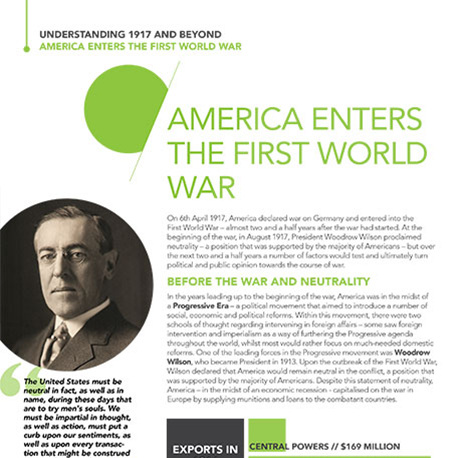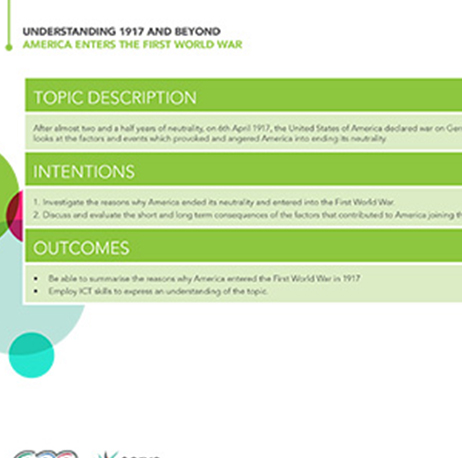
Understanding 1917 & Beyond
Lesson 4 - US Enter WWI
After almost two and a half years of neutrality, on 6th April 1917, the United States of America declared war on Germany and entered the First World War.
Resources with links to Statutory Requirements
Intentions
Intentions
- Examine a range of resources and explain why the U.S. entered the First World War in 1917.
- Using the information from the links as an example, prepare and complete a creative response to demonstrate knowledge and understanding of the topic.
Lusitania Sinking
Environment and Society (History)
(Objective 1) Developing pupils as Individuals
Explore how history has affected their personal identity, culture and lifestyle.
(Personal Understanding)
Investigate how history has been selectively interpreted to create stereotypical perceptions and to justify views and actions.
(Mutual Understanding)
(Objective 2) Developing pupils as Contributors to Society
Investigate the impact of significant events/ideas of the 20th century on the world.
(Cultural Understanding)
Critically investigate and evaluate the power of the media in their representation of a significant historical event or individual.
(Media Awareness)
Language and Literacy (English with Media Education)
(Objective 1) Developing pupils as Individuals
Engage, through language, with their peers and with fictional and real-life characters and situations, to explore their own emotions and develop creative potential.
(Personal Understanding)
Explore and respond to others’ emotions as encountered in literature, the media, moving image and peer discussion.
(Mutual Understanding)
Explore the use of language and imagery in conveying and evoking a variety of powerful feelings.
(Spiritual Awareness)
(Objective 2) Developing pupils as Contributors to Society
Use literature, drama, poetry or the moving image to explore others’ needs and rights.
(Citizenship)
Language and Literacy (Irish with Media Education)
(Objective 1) Developing pupils as Individuals
Engage, through language, with their peers and with fictional and real-life characters and situations, to explore their own emotions and develop creative potential.
(Personal Understanding)
Explore and respond to others’ emotions as encountered in literature, the media, moving image and peer discussion.
(Mutual Understanding)
Explore the use of language and imagery in conveying and evoking a variety of powerful feelings.
(Spiritual Awareness)
(Objective 2) Developing pupils as Contributors to Society
Use literature, drama, poetry or the moving image to explore others’ needs and rights.
(Citizenship)
LLW (Local and Global Citizenship)
Human Rights and Social Responsibility
Investigate local and global scenarios where human rights have been seriously infringed.
Creative Centenaries
Tags: Info, Comic
Zimmermann Telegram
Environment and Society (History)
(Objective 2) Developing pupils as Contributors to Society
Investigate the impact of significant events/ideas of the 20th century on the world.
(Cultural Understanding)
Investigate critical issues in history or historical figures who have behaved ethically or unethically.
(Ethical Awareness)
Language and Literacy (English with Media Education)
(Objective 1) Developing pupils as Individuals
Engage, through language, with their peers and with fictional and real-life characters and situations, to explore their own emotions and develop creative potential.
(Personal Understanding)
Explore and respond to others’ emotions as encountered in literature, the media, moving image and peer discussion.
(Mutual Understanding)
Explore the use of language and imagery in conveying and evoking a variety of powerful feelings.
(Spiritual Awareness)
Language and Literacy (Irish with Media Education)
(Objective 1) Developing pupils as Individuals
Engage, through language, with their peers and with fictional and real-life characters and situations, to explore their own emotions and develop creative potential.
(Personal Understanding)
Explore and respond to others’ emotions as encountered in literature, the media, moving image and peer discussion.
(Mutual Understanding)
Explore the use of language and imagery in conveying and evoking a variety of powerful feelings.
(Spiritual Awareness)
History Channel - Ask History
Tags: Info, Video
Lusitania
Environment and Society (History)
(Objective 1) Developing pupils as Individuals
Investigate how history has been selectively interpreted to create stereotypical perceptions and to justify views and actions.
(Mutual Understanding)
Investigate individuals who are considered to have taken a significant moral stand and examine their motivation and legacy.
(Moral Legacy)
(Objective 2) Developing pupils as Contributors to Society
Investigate the impact of significant events/ideas of the 20th century on the world.
(Cultural Understanding)
Critically investigate and evaluate the power of the media in their representation of a significant historical event or individual.
(Media Awareness)
Language and Literacy (English with Media Education)
(Objective 1) Developing pupils as Individuals
Develop the ability to use language (including body language) effectively in communicating with and relating to others.
(Mutual Understanding)
Explore the use of language and imagery in conveying and evoking a variety of powerful feelings.
(Spiritual Awareness)
Language and Literacy (Irish with Media Education)
(Objective 1) Developing pupils as Individuals
Explore the use of language and imagery in conveying and evoking a variety of powerful feelings.
(Spiritual Awareness)
Develop the ability to use language (including body language) effectively in communicating with and relating to others.
(Mutual Understanding)
History Channel
Tags: Info, Animation
U.S. Entry into WWI
Environment and Society (History)
(Objective 1) Developing pupils as Individuals
Investigate individuals who are considered to have taken a significant moral stand and examine their motivation and legacy.
(Moral Legacy)
(Objective 2) Developing pupils as Contributors to Society
Investigate the impact of significant events/ideas of the 20th century on the world.
(Cultural Understanding)
Investigate critical issues in history or historical figures who have behaved ethically or unethically.
(Ethical Awareness)
Language and Literacy (English with Media Education)
(Objective 1) Developing pupils as Individuals
Engage, through language, with their peers and with fictional and real-life characters and situations, to explore their own emotions and develop creative potential.
(Personal Understanding)
Explore and respond to others’ emotions as encountered in literature, the media, moving image and peer discussion.
(Mutual Understanding)
Develop the ability to use language (including body language) effectively in communicating with and relating to others.
(Mutual Understanding)
Explore the use of language and imagery in conveying and evoking a variety of powerful feelings.
(Spiritual Awareness)
Language and Literacy (Irish with Media Education)
(Objective 1) Developing pupils as Individuals
Engage, through language, with their peers and with fictional and real-life characters and situations, to explore their own emotions and develop creative potential.
(Personal Understanding)
Explore and respond to others’ emotions as encountered in literature, the media, moving image and peer discussion.
(Mutual Understanding)
Develop an understanding of the power of languages (including bi-lingualism and body language) to communicate and empathise with others.
(Mutual Understanding)
Explore the use of language and imagery in conveying and evoking a variety of powerful feelings.
(Spiritual Awareness)
Stanford History Education Group - Curriculum
Tags: Lesson Plan, Documents
U.S. Participation in WWI
Environment and Society (History)
(Objective 1) Developing pupils as Individuals
Investigate individuals who are considered to have taken a significant moral stand and examine their motivation and legacy.
(Moral Legacy)
(Objective 2) Developing pupils as Contributors to Society
Investigate the impact of significant events/ideas of the 20th century on the world.
(Cultural Understanding)
Investigate critical issues in history or historical figures who have behaved ethically or unethically.
(Ethical Awareness)
Language and Literacy (English with Media Education)
(Objective 1) Developing pupils as Individuals
Engage, through language, with their peers and with fictional and real-life characters and situations, to explore their own emotions and develop creative potential.
(Personal Understanding)
Explore and respond to others’ emotions as encountered in literature, the media, moving image and peer discussion.
(Mutual Understanding)
Develop the ability to use language (including body language) effectively in communicating with and relating to others.
(Mutual Understanding)
Explore the use of language and imagery in conveying and evoking a variety of powerful feelings.
(Spiritual Awareness)
Language and Literacy (Irish with Media Education)
(Objective 1) Developing pupils as Individuals
Engage, through language, with their peers and with fictional and real-life characters and situations, to explore their own emotions and develop creative potential.
(Personal Understanding)
Explore and respond to others’ emotions as encountered in literature, the media, moving image and peer discussion.
(Mutual Understanding)
Develop an understanding of the power of languages (including bi-lingualism and body language) to communicate and empathise with others.
(Mutual Understanding)
Explore the use of language and imagery in conveying and evoking a variety of powerful feelings.
(Spiritual Awareness)
The Arts (Drama)
(Objective 1) Developing pupils as Individuals
Explore and respond to the views and feelings of others.
(Mutual Understanding)
The Library of Congress - Progressive Era to New Era, 1900-1929
Tags: Info, Interview
Opportunities for Cross Curricular learning
Using ICT
The resources examine the topic utilizing a number of different media, which serve to engage pupils with the material, challenging them to think more creatively and encourage discussion.
The project could inspire tasks that would support presenting, researching, animation and working with sound.
Communication
The resources provide pupils with the opportunity to develop their talking and listening, reading and writing skills through independent learning and shared experience.
Opportunities for Thinking Skills and Personal Capabilities
Using the content, pupils have the opportunity to investigate meaning, explore ideas and analyse the information they are provided with. Within their individual learning, through group work and by questioning ideas, there is ample scope within the materials to include a focus on TS & PC. For this section, the following strands from the TS & PC framework are the most obvious to consider:
Managing Information
Pupils have the opportunity to:
- ask focused questions;
- use a range of methods for collating, recording and representing information; and
- communicate with a sense of audience and purpose.
Thinking, Problem-Solving and Decision-Making
Pupils have the opportunity to:
- sequence, order, classify, and make comparisons;
- use different types of questions; and
- make connections between learning in different contexts.
Being Creative
Pupils have the opportunity to:
- make new connections between ideas/information;
- learn from and value other people’s ideas;
- challenge the routine method; and
- take risks for learning.
Working with Others
Pupils have the opportunity to:
- give and respond to feedback;
- take personal responsibility for work with others and evaluate their own contribution to the group; and
- suggest ways of improving their approach to working collaboratively.
Self-Management
Pupils have the opportunity to:
- organise and plan how to go about a task;
- focus, sustain attention and persist with tasks; and
- compare their own approach with others’ and in different contexts
Opportunities to develop
Possible Task
Plan and create an animation about the sinking of the Lusitania.
Using the downloadable resource pack from the Creative Centenaries website, create a 2D animation which tells the story of the sinking of the Lusitania. Each animation should also have a voiceover explaining what happened why it was relevant.
Areas of Learning: The Arts (Art and Design), Language and Literacy (English/Irish with Media Education), Environment and Society (History)
Plan and create a design for a recruitment poster using the style and imagery of the period.
Investigate some of the posters used to publicise the need for recruits to join the armed forces. Note the appeals to patriotism and duty, and the figures used to attract attention. Using typefaces and designs that reflect the style seen in the period examples, draft the copy for a recruitment poster and an image to use.
Areas of Learning: The Arts (Art and Design), Language and Literacy (English/Irish with Media Education), Environment and Society (History)



